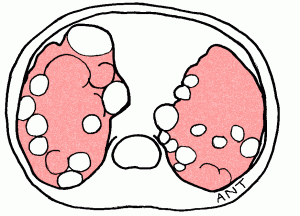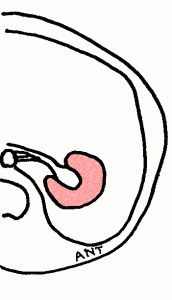This page has quite detailed information about PKD. Read a shorter introduction or jump to who should get Tolvaptan?
March 2020: COVID-19 and Tolvaptan – treatment with Tolvaptan during the coronavirus epidemic.
What happens in polycystic kidney disease?
Polycystic kidney disease (often shortened to PKD or ADPKD for Autosomal Dominant PKD) is the commonest inherited cause of kidney failure. Not everyone with PKD gets trouble from their kidneys, but up to 10% of patients on dialysis or with a kidney transplant are due to PKD.
Overall about 50% of patients with PKD require dialysis or a kidney transplant at some time in their lives, but this varies between families. In some families kidney failure tends to occur in middle age, in others it happens in old age, or not at all. However you may get trouble much earlier or later than your family average.
Can anything else cause kidney cysts?
It is quite common for healthy people to have one or two cysts, and occasionally people may have several. But when the kidneys are enlarged and filled with many cysts, PKD is the most likely diagnosis. There are some other rare diseases that very occasionally cause many kidney cysts.
Infantile polycystic kidney disease (ARPKD, Autosomal Recessive Kidney Disease) is rare, causes liver damage as well as kidney trouble, and can cause very severe illness in infancy and childhood. It is not the same as the disease that occurs in adults. (More about ARPKD rarerenal.org)
What kidney trouble does PKD cause?
Almost all patients with PKD develop high blood pressure – this is a problem with many kidney diseases. They often have abnormal urine tests also.
If you have many cysts when you are very young, renal failure and other kidney problems are more likely.
The cysts may cause pain if there is bleeding into them, and sometimes they may become infected, requiring antibiotic treatment. Very large kidneys may cause discomfort just because of their size. Occasionally bleeding may occur into the urine which may look dramatic, but usually settles on its own.
What else can PKD do?
Cerebral aneurysms: Some people with PKD develop weaknesses of blood vessels beneath the brain, which develop into aneurysms (swellings) that can rupture to cause a subarachnoid haemorrhage. This is unusual, but more likely to happen in some families. Treatment for any aneurysms that are found carries significant risks. Screening is therefore only suggested if a close family member has had a subarachnoid haemorrage.
Kidney stones: People with PKD get more kidney stones than others. It is not known why. The diagnosis may be hard to make, because PKD patients may often have blood in their urine on testing, and they have other reasons for pain in the region of the kidneys.
Other: People with PKD are more likely to develop hernias. This can be a problem on peritoneal dialysis. Diverticular disease of the colon is more common. And there seems to be an increased rate of ‘floppiness’ of one of the heart valves, although this is rarely important.
Can I pass it on to my children?
Yes. On average, 1 in 2 of your children will inherit the faulty gene. There can be quite a lot of variation in severity within one family, so that while the average age of kidney failure may be (for example) aound 50, there could be family members getting kidney failure in their 30s or younger, and some who never do.
PKD may be inherited from either your mother or your father. They may not know that they carry the disease. Sometimes the disease appears in a family for the first time.
How can family members tell whether they have the disease?
The simplest test is an ultrasound scan, which does not involve exposure to X-rays or any discomfort. This can show cysts developing. If it shows a lot of cysts, you definitely have the disease. Unfortunately, because the cysts develop very slowly in some people, a negative result does not prove that you do not have the disease until you are about 30yrs old. However the later you develop cysts, the less likely they are to cause you any serious health problems. Other types of scan, such as a CT or MRI scan, may help if there is uncertainty, and can now be part of assessing whether treatment is justified (see below).
First signs of the disease usually occur in early adult life. There may be blood in the urine on testing, and high blood pressure. It is unusual to have other symptoms early on.
Can I have genetic testing?
Genetic testing uses your own DNA (usually from a blood test) to identify whether you have inherited a particular condition or gene. The genes involved in PKD are large and complicated, but testing methods are getting much better. Tests are now available for some families in the UK, e.g. if someone wants to be a kidney donor. It is likely that genetic tests will become more routine in the next few years.
Sometimes the tests don’t give a definite answer.
Looking for cysts may still be a quicker way to show that you have PKD. However not seeing cysts doesn’t give you a definite ‘No’ until you are about 30.
Treatments to slow PKD
There isn’t a cure for PKD, but treatment is now becoming available to slow down the growth of cysts. All treatments are likely to have some risks and possible side effects.
Tolvaptan (Jinarc) is the first drug licensed to slow PKD. While taking it, cysts grow less quickly. In trials in patients with quite enlarged kidneys, it slowed down loss of kidney function by about 30%. So if you were going to get kidney failure in 15 years, this could stretch it out to 20.
Tolvaptan is taken twice a day. Like all medicines there are side effects, but two are most important:
- It makes you produce more urine during the day and at night. You have to drink a lot to prevent dehydration. Some people are unable to tolerate this side effect, even at a low dose.
- Some patients have developed abnormal liver tests after they have been on treatment the for 6-18 months. This is worrying as other drugs can sometimes cause very severe liver disease. Monthly blood tests are required to guard against this.
We are going to find out how best to use this treatment over the next 10 years – and hope that other treatments may be added to have greater effect. Those likely to benefit the most are those more likely to develop kidney failure in the next decade, or few decades. There are ways to spot this:
- kidney function is already slipping a bit, but not too much. In the UK it is usually required that it is better than eGFR 30, about 30% kidney function.
- kidneys are very large. There are ways to measure this more precisely if this looks likely.
- you are from a family in which early kidney failure is usual.
- you have a genetic mutation likely to be ‘severe’
Our Edinburgh algorithm for Tolvaptan is written mainly for clinicians, and is linked from the foot of this page.
Things to remember:
- We we don’t yet know how safe the drug is in patients who are elderly, or who have other serious conditions.
- We don’t yet know how young you should start it, but only adults have been treated so far.
- It is not known whether it is safe to get pregnant on it, so woman should use effective contraception.
- Other medicinces that make you pass more urine (diuretics) should not be combined with it.
- You should miss it out if you are likely to get dehydrated, e.g. if you have vomiting or diarrhea, or are about to run a long distance race.
Other things need to be treated too
Most patients with PKD develop high blood pressure which continues for the rest of their lives unless treated effectively. High blood pressure can have serious effects on the heart and blood vessels. It should be treated for this reason.
If there is chronic renal failure (CKD), this should be looked after in the usual way.
Infected cysts occur uncommonly but need antibiotic treatment when they do.
Sometimes the big kidneys are uncomfortable, and occasionally bleeding into a cyst can cause pain. Severe continuing pain is uncommon. If it occurs often it needs to be managed cautiously, or high intake of painkillers may cause new problems.
If kidney failure occurs, dialysis and transplantation are very successful in people with PKD. Kidney transplantation is the best way of regaining full health. Occasionally the kidneys by then are so big that one or both must be removed to make space for dialysis or for a kidney transplant. Removing a kidney this size is a big operation, and it removes any remaining kidney function, so it is only done if it is essential.
Should I test my children?
There isn’t any treatment for early stage PKD, and scans may miss the diagnosis in young people. So it is usually advised that children should not be tested until they are old enough to make their own decision. Even with new treatments becoming available that is still true, as treatment would not be started so young. This advice may change over the years as our understanding of possible treatments develops further.
It is probably worth occasionally (every few years) checking the blood pressure of children who are at risk of PKD, as this is rarely an early problem that needs treatment.
Where can I get further information?
More info from edren.org/info
- Got PKD? A page to help people get tested, and work out whether they should think about treatment (aimed at patients and as a starting point for referring clinicians)
- Our treatment pathway for Tolvaptan in PKD (aimed at clinicians)
- Simpler information about PKD
PKD is quite a common disorder and a lot of other information is available. Several patient associations and charities run websites and provide written information.
The following external sites are particularly good:
- Patient information about PKD from the UK RareRenal website
- The UK-based PKD Charity (pkdcharity.org.uk) provides support and very good information.
- The US-based Polycystic Kidney Research Foundation (pkdcure.org) provides a very good website.
- NKF (UK) on PKD
These edren pages contain relevant information beyond info about PKD itself:
Do you know other sources that should be included? Let us know
Acknowledgements: The original author of this page was Neil Turner with Mike Watson. It was first published in August 2001. Major revisions February 2016. The date it was last modified is shown in the footer.




